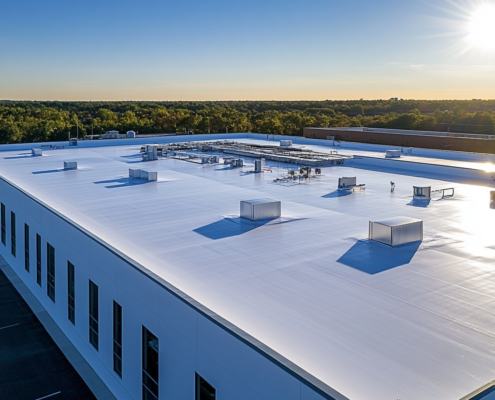Why Thermoplastic Polyolefin Roofing (TPO) is the Preferred Choice for Modern, Energy-Efficient Roofing
Thermoplastic Polyolefin (TPO) roofing is quickly gaining popularity for both commercial and residential buildings. Its combination of durability, energy efficiency, and eco-friendly properties makes it an ideal choice for a variety of roofing applications. Specifically designed for flat or low-slope roofs, thermoplastic polyolefin roofing offers exceptional weather resistance and a low-maintenance solution that can withstand harsh conditions while also reducing energy costs. This guide will walk you through the benefits of thermoplastic polyolefin roofing, its installation process, maintenance tips, cost considerations, and how it compares to other popular roofing materials.
What is TPO Roofing?
Thermoplastic Polyolefin (TPO) roofing is a single-ply membrane that combines the best features of both rubber and plastic. This material is highly durable, flexible, and energy-efficient. Typically, TPO roofing is composed of three main layers:
- TPO Polymer Base: Provides flexibility and durability.
- Polyester-Reinforced Fabric Center: Adds strength and puncture resistance.
- TPO Compounded Top Ply: Ensures UV and chemical resistance, ensuring longevity.
This combination of materials gives TPO roofing its unique properties, making it suitable for flat or low-slope roofs. It provides long-lasting, weather-resistant protection while maintaining its aesthetic appeal.
Key Advantages of TPO Roofing Systems
1. Exceptional Durability and Weather Resistance
One of the standout features of TPO roofing is its ability to withstand extreme weather conditions. Whether it’s high winds, heavy rain, or temperature fluctuations, TPO roofing is built to endure.
- TPO membranes are UV-resistant, which helps to prevent fading, chalking, and degradation caused by sun exposure.
- The material is also resistant to chemicals, making it perfect for buildings exposed to pollutants or industrial environments.
2. Energy Efficiency and Cost Savings
TPO roofing is particularly known for its energy-saving benefits. Thanks to its reflective properties, thermoplastic polyolefin roofing reduces heat absorption, keeping buildings cooler during the hot summer months. This not only minimizes the need for air conditioning but also contributes to lower energy bills.
- Many TPO membranes are Energy Star-rated, which makes them a great option for those interested in sustainable and cost-effective solutions.
3. Environmentally Friendly and Sustainable
An environmentally friendly roofing solution, thermoplastic polyolefin roofing is manufactured without chlorine, and many TPO membranes contain recycled content. Additionally, TPO is fully recyclable at the end of its lifespan, contributing to a circular economy.
- The reflective nature of TPO helps reduce the urban heat island effect in densely populated areas, contributing to sustainable urban planning.
4. Low Maintenance and Repair-Friendly
Unlike traditional roofing systems, thermoplastic polyolefin roofing requires minimal maintenance. If small punctures or tears occur, they can often be repaired easily with inexpensive patch kits. Routine inspections are usually enough to maintain the roof’s condition over time.
- The durability of thermoplastic polyolefin roofing’s seams, which are heat-welded during installation, significantly reduces the likelihood of leaks.
5. Aesthetic Flexibility
TPO membranes come in several colors, including white, gray, and tan. White is particularly popular due to its high reflectivity, but other colors can be selected to match building aesthetics.
- This variety in color options allows you to choose a TPO roof that aligns with your design preferences while still offering the benefits of energy efficiency.

High-quality thermoplastic polyolefin roofing installation ensures energy efficiency and durability.
TPO Roofing Installation: A Step-by-Step Guide
The installation of TPO roofing is generally quicker and more cost-effective than traditional roofing systems, thanks to its single-ply membrane structure. Here’s an overview of the installation process:
Step 1: Preparation and Roof Surface Cleaning
Before starting installation, the roof surface must be cleaned to remove any existing materials, debris, and obstacles. This creates a smooth foundation for the membrane to adhere to.
- Proper preparation ensures a strong bond between the TPO membrane and the roof surface.
Step 2: Laying Out the TPO Membrane
The TPO membrane is unrolled and laid out over the roof. Each section should overlap slightly to allow for secure seam welding. Proper alignment and spacing are crucial to avoid gaps or wrinkles.
- Attention to detail is critical during this step to ensure that the roof maintains its integrity.
Step 3: Securing the TPO Membrane with Fasteners or Adhesive
The membrane can be secured using one of two methods:
- Mechanical Fastening: Corrosion-resistant screws and plates are used to anchor the membrane to the roof deck. This method is ideal for areas that experience high winds.
- Fully Adhered: A specialized adhesive is applied to bond the TPO membrane to the substrate. This method is often chosen for buildings where appearance is a top priority.
Step 4: Heat-Welding the Seams
After securing the membrane, a hot-air welder is used to fuse the seams together. This step is essential in creating a watertight bond and ensuring long-term durability.
- Heat-welded seams are often stronger than the membrane itself, preventing leaks and ensuring a solid roofing system.
Step 5: Adding Reinforcements at Vulnerable Areas
Flashing is applied around roof penetrations like vents and chimneys, which are common areas where water may seep in. A final sealant is often applied for additional waterproofing.
- Reinforcements are essential in ensuring the roof remains watertight.
Maintenance and Longevity of Thermoplastic Polyolefin Roofing Systems
With proper care, thermoplastic polyolefin roofing systems can last between 20 to 30 years. The lifespan largely depends on factors such as climate, installation quality, and regular maintenance.
Maintenance Tips:
- Regular Inspections: Conduct inspections at least twice a year—usually in spring and fall—and after extreme weather events.
- Roof Surface Cleaning: Clean the TPO membrane once or twice a year using mild soap and water. Avoid harsh chemicals that could damage the material.
- Prompt Repairs: If small punctures or tears occur, use TPO-compatible patch kits and heat-weld them for a long-lasting fix.
Cost Considerations for TPO Roofing
The cost of a TPO roofing system varies based on factors like the thickness of the membrane, building size, and the installation method. Here’s a general breakdown:
- Material Cost: TPO membranes typically range from $5 to $9 per square foot.
- Installation Cost: Professional installation can add another $4 to $6 per square foot, though rates vary by region.
- Total Cost Estimate: For a standard commercial roof, TPO installation costs range from $9 to $15 per square foot.
Comparing TPO with Other Popular Roofing Options
TPO vs. PVC Roofing
- Durability: PVC has a slight edge in terms of chemical and fire resistance. However, TPO roofing is often more cost-effective and environmentally friendly.
- Environmental Impact: TPO roofing is chlorine-free and generally considered greener due to its recyclability.
TPO vs. EPDM Roofing
- Weather Resistance: While TPO roofing offers better UV protection, EPDM performs well in colder climates.
- Cost: EPDM roofing is often more affordable upfront, but TPO’s energy-saving benefits may provide long-term savings.
Frequently Asked Questions About TPO Roofing
How Long Does a TPO Roof Last?
With proper maintenance, TPO roofing can last between 20 to 30 years, providing long-term protection for both residential and commercial buildings.
Is TPO Roofing Eco-Friendly?
Yes, TPO roofing is environmentally friendly due to its recyclability, absence of harmful chemicals, and its ability to reduce the urban heat island effect.
Can I Install TPO Roofing Over an Existing Roof?
In many cases, TPO roofing can be installed over an existing roof if local building codes allow and the current roof is in good condition.
How Does TPO Compare to Other Materials in Terms of Energy Efficiency?
TPO roofing is one of the most energy-efficient roofing materials available due to its high reflectivity, making it particularly effective in hot climates.
Final Thoughts
Thermoplastic Polyolefin roofing is an excellent choice for modern, energy-efficient roofing solutions. Its combination of durability, weather resistance, energy efficiency, and low maintenance makes it ideal for commercial and residential properties. Whether you’re considering a TPO roofing system for a new building or replacing an old roof, it offers long-term benefits that can lower energy costs and improve building performance.







